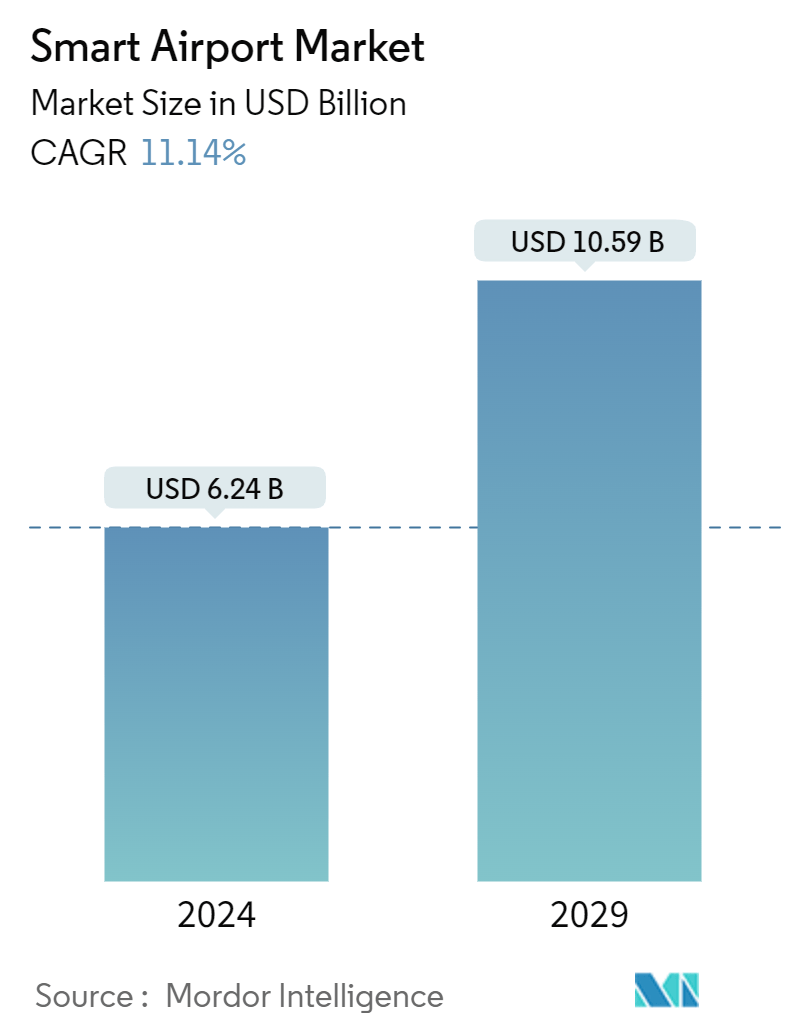Market Size of Smart Airport Industry

| Study Period | 2019 - 2029 |
| Market Size (2024) | USD 6.24 Billion |
| Market Size (2029) | USD 10.59 Billion |
| CAGR (2024 - 2029) | 11.14 % |
| Fastest Growing Market | Asia Pacific |
| Largest Market | North America |
| Market Concentration | Low |
Major Players
*Disclaimer: Major Players sorted in no particular order |
Smart Airport Market Analysis
The Smart Airport Market size is estimated at USD 6.24 billion in 2024, and is expected to reach USD 10.59 billion by 2029, growing at a CAGR of 11.14% during the forecast period (2024-2029).
Several factors are driving the growth of the smart airport market, including the rebound in passenger traffic, the adoption of advanced technologies (ranging from IT and electronics to robotics and data analytics) for cost-effective management, and a heightened focus on enhancing the passenger experience. As airports digitize operations and pivot toward self-service solutions, there is also a rising demand for advanced kiosks.
Now integrating biometrics for swifter processing, these kiosks are set to further bolster the smart airport market. With global investments pouring into new greenfield airports and expanding existing ones, the stage is set for a surge in smart airport technology demand. However, it is worth noting that technological challenges and the escalating frequency of power outages at airports worldwide pose potential risks to airport kiosk systems.
Smart Airport Industry Segmentation
The concept of a smart airport, akin to smart cities, buildings, and factories, emphasizes advanced infrastructure. This infrastructure encompasses communication systems, cargo and baggage handling, security, ground handling, parking solutions, air traffic management, and facilities like aircraft hangars and parking. Terminal operations further involve passenger and staff notifications, information displays, lighting, and announcements.
The global smart airport market is segmented by technology, airport operations, and geography. By technology, the market is segmented into security systems, communication systems, air and ground traffic control, and passenger, cargo, and baggage ground handling. By airport operation, the market is segmented into the landside, airside, and terminal side. The report also covers the market sizes and forecasts for the smart airport market in major countries across different regions. For each segment, the market size is provided in terms of value (USD).
| By Technology | |
| Security Systems | |
| Communication Systems | |
| Air and Ground Traffic Control | |
| Passenger, Cargo, and Baggage Ground Handling |
| By Airport Operation | |
| Landside | |
| Airside | |
| Terminal Side |
| By Geography | |||||||
| |||||||
| |||||||
| |||||||
| |||||||
|
Smart Airport Market Size Summary
The smart airport market is experiencing significant growth, driven by the resurgence in passenger traffic and the integration of advanced technologies such as IT, electronics, robotics, and data analytics. These technologies are being adopted to manage airport operations more cost-effectively and to enhance the passenger experience. The shift towards digitization and self-service solutions is increasing the demand for advanced kiosks, which are now incorporating biometric systems for faster processing. This trend is further supported by global investments in new airport constructions and the expansion of existing facilities, which are expected to boost the demand for smart airport technologies. However, challenges such as technological issues and frequent power outages at airports could pose risks to the implementation of these systems.
The Asia-Pacific region is anticipated to witness substantial growth in the smart airport sector, fueled by significant investments in airport infrastructure. Countries like China, India, Japan, and South Korea are seeing a rise in passenger traffic, prompting government and airport authorities to announce major investments. These funds are being allocated to expand current airports, build new terminals, and implement advanced security measures. Regional airports are also adopting smart solutions to improve operational efficiency and passenger services. The market is highly fragmented, with key players like RTX Corporation, SITA, Honeywell International Inc., Siemens AG, and Cisco Systems, Inc. leading the charge. Strategic partnerships and collaborations, such as those between Air Liquide and Groupe ADP, are focusing on developing sustainable and smart infrastructure, further propelling the market's growth.
Smart Airport Market Size - Table of Contents
-
1. MARKET DYNAMICS
-
1.1 Market Overview
-
1.2 Market Drivers
-
1.3 Market Restraints
-
1.4 Porter's Five Forces Analysis
-
1.4.1 Bargaining Power of Buyers/Consumers
-
1.4.2 Bargaining Power of Suppliers
-
1.4.3 Threat of New Entrants
-
1.4.4 Threat of Substitute Products
-
1.4.5 Intensity of Competitive Rivalry
-
-
-
2. MARKET SEGMENTATION
-
2.1 By Technology
-
2.1.1 Security Systems
-
2.1.2 Communication Systems
-
2.1.3 Air and Ground Traffic Control
-
2.1.4 Passenger, Cargo, and Baggage Ground Handling
-
-
2.2 By Airport Operation
-
2.2.1 Landside
-
2.2.2 Airside
-
2.2.3 Terminal Side
-
-
2.3 By Geography
-
2.3.1 North America
-
2.3.1.1 United States
-
2.3.1.2 Canada
-
-
2.3.2 Europe
-
2.3.2.1 United Kingdom
-
2.3.2.2 France
-
2.3.2.3 Germany
-
2.3.2.4 Italy
-
2.3.2.5 Rest of Europe
-
-
2.3.3 Asia-Pacific
-
2.3.3.1 China
-
2.3.3.2 India
-
2.3.3.3 Japan
-
2.3.3.4 South Korea
-
2.3.3.5 Rest of Asia-Pacific
-
-
2.3.4 Latin America
-
2.3.4.1 Brazil
-
2.3.4.2 Rest of Latin America
-
-
2.3.5 Middle East and Africa
-
2.3.5.1 Saudi Arabia
-
2.3.5.2 United Arab Emirates
-
2.3.5.3 Rest of Middle East and Africa
-
-
-
Smart Airport Market Size FAQs
How big is the Smart Airport Market?
The Smart Airport Market size is expected to reach USD 6.24 billion in 2024 and grow at a CAGR of 11.14% to reach USD 10.59 billion by 2029.
What is the current Smart Airport Market size?
In 2024, the Smart Airport Market size is expected to reach USD 6.24 billion.

